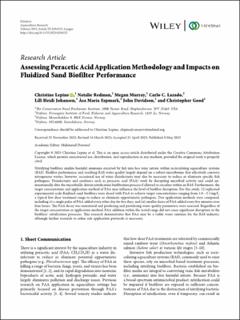| dc.contributor.author | Lepine, Christine | |
| dc.contributor.author | Redman, Natalie | |
| dc.contributor.author | Murray, Megan | |
| dc.contributor.author | Lazado, Carlo C. | |
| dc.contributor.author | Johansen, Lill-Heidi | |
| dc.contributor.author | Espmark, Åsa Maria Olofsdotter | |
| dc.contributor.author | Davidson, John | |
| dc.contributor.author | Good, Christopher | |
| dc.date.accessioned | 2023-07-10T07:53:51Z | |
| dc.date.available | 2023-07-10T07:53:51Z | |
| dc.date.created | 2023-05-09T19:11:40Z | |
| dc.date.issued | 2023 | |
| dc.identifier.issn | 1355-557X | |
| dc.identifier.uri | https://hdl.handle.net/11250/3077430 | |
| dc.description.abstract | Nitrifying biofilters oxidize harmful ammonia excreted by fish into less toxic nitrate within recirculating aquaculture systems (RAS). Biofilter performance and resulting RAS water quality largely depend on a robust microbiome that effectively converts nitrogenous wastes; however, occasional use of water disinfectants may also be necessary to reduce or eliminate specific fish pathogens. Disinfectants and sanitizers such as peracetic acid (PAA) work by disrupting microbial activity and could unintentionally alter the microbially-driven nitrification biofiltration process if allowed to circulate within an RAS. Furthermore, the target concentration and application method of PAA may influence the level of biofilter disruption. For this study, 12 replicated experimental-scale fluidized sand biofilters were dosed with PAA to achieve target concentrations ranging from 1.0-–2.5 mg/L, a typical low-dose treatment range to reduce or eliminate opportunistic pathogens. Two application methods were compared, including (i) a single pulse of PAA added every other day for five days, and (ii) smaller doses of PAA added every five minutes over four hours. The PAA decay was monitored and predosing and postdosing water quality parameters were assessed. Regardless of the target concentration or application method, PAA addition within the tested range did not cause significant disruption to the biofilters’ nitrification processes. This research demonstrates that PAA may be a viable water sanitizer for the RAS industry, although further research to refine safe application protocols is necessary. | |
| dc.description.abstract | Assessing Peracetic Acid Application Methodology and Impacts on Fluidized Sand Biofilter Performance | |
| dc.language.iso | eng | |
| dc.title | Assessing Peracetic Acid Application Methodology and Impacts on Fluidized Sand Biofilter Performance | |
| dc.title.alternative | Assessing Peracetic Acid Application Methodology and Impacts on Fluidized Sand Biofilter Performance | |
| dc.type | Peer reviewed | |
| dc.type | Journal article | |
| dc.description.version | publishedVersion | |
| dc.source.volume | 2023 | |
| dc.source.journal | Aquaculture Research | |
| dc.identifier.doi | 10.1155/2023/6294325 | |
| dc.identifier.cristin | 2146599 | |
| dc.relation.project | Norges forskningsråd: 237856 | |
| cristin.ispublished | true | |
| cristin.fulltext | original | |
| cristin.qualitycode | 1 | |
